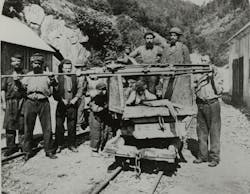The First Percussion Drill
On January 8, 1851, construction began on a 4.75-mile-long railroad tunnel, at the time the longest in North America and second-longest in the world, under Hoosac Mountain in Massachusetts. To tunnel such a distance through hard rock would be a mighty task for many John Henrys with their 10-pound hammers, and the need arose for the first high-production mechanical rock drill. Several inventors and entrepreneurs tried to meet this need.
The Historical Construction Equipment Association (HCEA) is a 501(c)3 nonprofit organization dedicated to preserving the history of the construction, dredging, and surface mining equipment industries. With over 4,000 members in 25 countries, activities include publication of a quarterly educational magazine, Equipment Echoes, from which this article is adapted; operation of National Construction Equipment Museum and archives in Bowling Green, Ohio; and hosting an annual working exhibition of restored construction equipment. Our 2018 show will be August 24-26 at the Le Sueur Pioneer Power Show in Le Sueur, Minn. Individual memberships within the U.S. and Canada are $35 for one year, $66.95 for two years, and $99.95 for three years, and $45 elsewhere. We seek to develop relationships in the equipment manufacturing industry, and we offer a college scholarship for engineering and construction management students. Information is available at www.hcea.net, or by calling 419.352.5616 or e-mailing [email protected].
In 1849, Jonathan J. Couch had patented the world’s first percussion rock drill. The drill steel passed through a piston. The steel was launched by steam like a lance, seized in a gripper box on the recoil when the engine valve released the driving pressure, and rotated after every stroke. It worked on granite blocks, but was not commercially successful.
Couch’s former assistant, Joseph Fowle, patented a variation of this drill in 1851, in which the steel was mounted directly to the drill’s operating piston. It promised to be more successful than the Couch design, but was doomed by lack of financial backing.
The first compressed-air drill was patented in Europe in 1857. Meanwhile, in the United States, patents were issued to G.H. Wood, J. D. Hope, and L.P. Jenks for modifications to the steel and the use of springs to advance the steel from the force of its recoil. A “portable” unit—weighing 590 pounds—that mated a drill to a steam engine’s cylinder and valve motion was patented in 1861 by William Harsen. A Harsen drill was tried at Hoosac and found wanting.
Herman Haupt’s ideas were next. He was awarded patents in 1864 and 1865 for a piston that struck the steel like a hammer, a spiral ratchet to rotate the steel, and a gripper to regulate feed. However, the gripper’s cams and collars were problematic, and these too failed at Hoosac.
Steam-engine builder Charles R. Burleigh, with aid from S.F. Gates and one W. Brooks, patented in 1866 an improvement on the ideas of Couch, Haupt, and Harsen. Their pneumatic tool could drill 3.3 inches of 1.75-inch-diameter hole per minute, and the Hoosac Tunnel Commission ordered 40 of them. Weighing more than 200 pounds each, they were gang-mounted on early versions of drill jumbos. Although productive, they quickly pounded themselves to pieces; a quarter of them were down for repairs at any given time.
Burleigh went back to the drawing board and incorporated Fowle’s concept of attaching the steel to the piston rod and Harsen’s means of rotating the piston and steel as a unit. But the major breakthrough was modifying the drill’s exhaust so that the discharged air cushioned the recoil, greatly reducing the pummeling the drill took from the blows.
The redesigned drill was tested successfully on Nov. 1, 1866, and deployed shortly thereafter. Performance and reliability were greatly improved, and maintenance was far less expensive. The only real problem was their voracious appetite for drill steel; they went through 3 tons a month, and blacksmiths were kept busy sharpening the steel while it lasted.
The introduction of the Burleigh drill into the Hoosac Tunnel marked the beginning of modern tunneling. Mechanically powered rock drilling was no longer a dream or an inventor’s tinkering—it was finally a practical reality.
—This report was adapted from an article by Cliff Shexnayder, published in Equipment Echoes.
